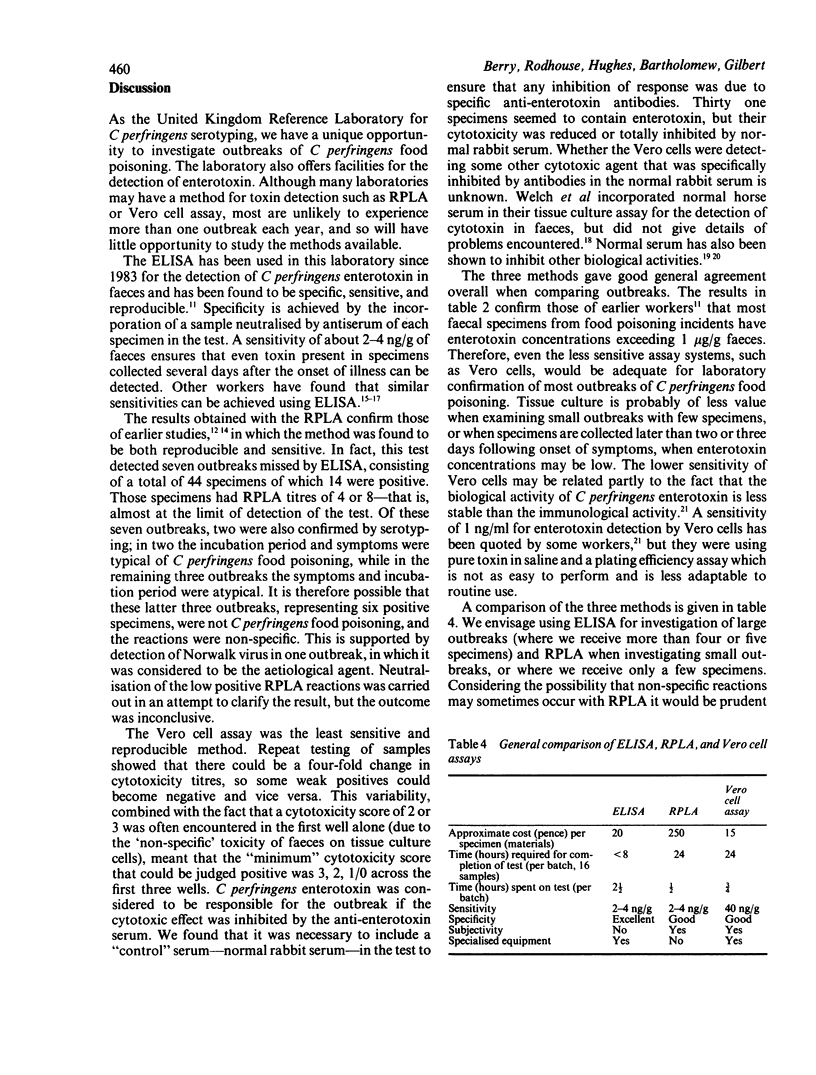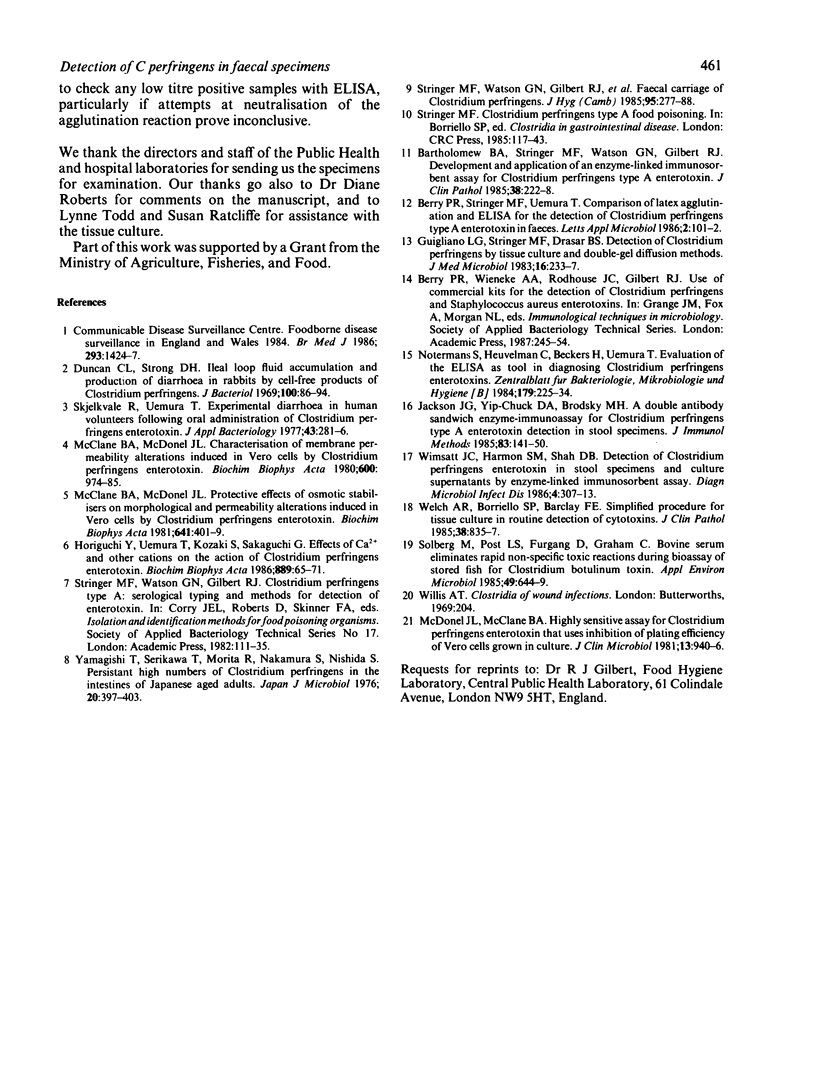Abstract
Three hundred and ninety two faecal specimens from 70 separate outbreaks of suspected Clostridium perfringens food poisoning were examined by enzyme linked immunosorbent assay (ELISA), reversed passive latex agglutination (RPLA), and Vero cell assays for the presence of enterotoxin. Although the most time consuming method, ELISA was the most specific and reproducible. RPLA was slightly more sensitive than ELISA, but it showed some non-specific reactions. The Vero cell assay was the least sensitive and least reproducible method, being affected by some non-specific cytotoxic and cytotonic reactions. Normal rabbit serum should be included in the Vero cell assay as a control for the neutralisation of cytotoxic effects.
Full text
PDF



Selected References
These references are in PubMed. This may not be the complete list of references from this article.
- Bartholomew B. A., Stringer M. F., Watson G. N., Gilbert R. J. Development and application of an enzyme linked immunosorbent assay for Clostridium perfringens type A enterotoxin. J Clin Pathol. 1985 Feb;38(2):222–228. doi: 10.1136/jcp.38.2.222. [DOI] [PMC free article] [PubMed] [Google Scholar]
- Duncan C. L., Strong D. H. Ileal loop fluid accumulation and production of diarrhea in rabbits by cell-free products of Clostridium perfringens. J Bacteriol. 1969 Oct;100(1):86–94. doi: 10.1128/jb.100.1.86-94.1969. [DOI] [PMC free article] [PubMed] [Google Scholar]
- Giugliano L. G., Stringer M. F., Drasar B. S. Detection of Clostridium perfringens enterotoxin by tissue culture and double-gel diffusion methods. J Med Microbiol. 1983 May;16(2):233–237. doi: 10.1099/00222615-16-2-233. [DOI] [PubMed] [Google Scholar]
- Horiguchi Y., Uemura T., Kozaki S., Sakaguchi G. Effects of Ca2+ and other cations on the action of Clostridium perfringens enterotoxin. Biochim Biophys Acta. 1986 Oct 31;889(1):65–71. doi: 10.1016/0167-4889(86)90009-1. [DOI] [PubMed] [Google Scholar]
- Jackson S. G., Yip-Chuck D. A., Brodsky M. H. A double antibody sandwich enzyme-immunoassay for Clostridium perfringens type A enterotoxin detection in stool specimens. J Immunol Methods. 1985 Oct 24;83(1):141–150. doi: 10.1016/0022-1759(85)90067-5. [DOI] [PubMed] [Google Scholar]
- McClane B. A., McDonel J. L. Characterization of membrane permeability alterations induced in Vero cells by Clostridium perfringens enterotoxin. Biochim Biophys Acta. 1980 Aug 14;600(3):974–985. doi: 10.1016/0005-2736(80)90499-x. [DOI] [PubMed] [Google Scholar]
- McClane B. A., McDonel J. L. Protective effects of osmotic stabilizers on morphological and permeability alterations induced in Vero cells by Clostridium perfringens enterotoxin. Biochim Biophys Acta. 1981 Mar 6;641(2):401–409. doi: 10.1016/0005-2736(81)90496-x. [DOI] [PubMed] [Google Scholar]
- Notermans S., Heuvelman C., Beckers H., Uemura T. Evaluation of the ELISA as tool in diagnosing Clostridium perfringens enterotoxins. Zentralbl Bakteriol Mikrobiol Hyg B. 1984 Jun;179(3):225–234. [PubMed] [Google Scholar]
- Skjelkvåle R., Uemura T. Experimental Diarrhoea in human volunteers following oral administration of Clostridium perfringens enterotoxin. J Appl Bacteriol. 1977 Oct;43(2):281–286. doi: 10.1111/j.1365-2672.1977.tb00752.x. [DOI] [PubMed] [Google Scholar]
- Solberg M., Post L. S., Furgang D., Graham C. Bovine serum eliminates rapid nonspecific toxic reactions during bioassay of stored fish for Clostridium botulinum toxin. Appl Environ Microbiol. 1985 Mar;49(3):644–649. doi: 10.1128/aem.49.3.644-649.1985. [DOI] [PMC free article] [PubMed] [Google Scholar]
- Stringer M. F., Watson G. N., Gilbert R. J., Wallace J. G., Hassall J. E., Tanner E. I., Webber P. P. Faecal carriage of Clostridium perfringens. J Hyg (Lond) 1985 Oct;95(2):277–288. doi: 10.1017/s0022172400062707. [DOI] [PMC free article] [PubMed] [Google Scholar]
- Welch A. R., Borriello S. P., Barclay F. E. Simplified procedure for tissue culture in routine detection of cytotoxins. J Clin Pathol. 1985 Jul;38(7):835–837. doi: 10.1136/jcp.38.7.835. [DOI] [PMC free article] [PubMed] [Google Scholar]
- Wimsatt J. C., Harmon S. M., Shah D. B. Detection of Clostridium perfringens enterotoxin in stool specimens and culture supernatants by enzyme-linked immunosorbent assay. Diagn Microbiol Infect Dis. 1986 Apr;4(4):307–313. doi: 10.1016/0732-8893(86)90071-4. [DOI] [PubMed] [Google Scholar]
- Yamagishi T., Serikawa T., Morita R., Nakamura S., Nishida S. Persistent high numbers of Clostridium perfringens in the intestines of Japanese aged adults. Jpn J Microbiol. 1976 Oct;20(5):397–403. doi: 10.1111/j.1348-0421.1976.tb01005.x. [DOI] [PubMed] [Google Scholar]


